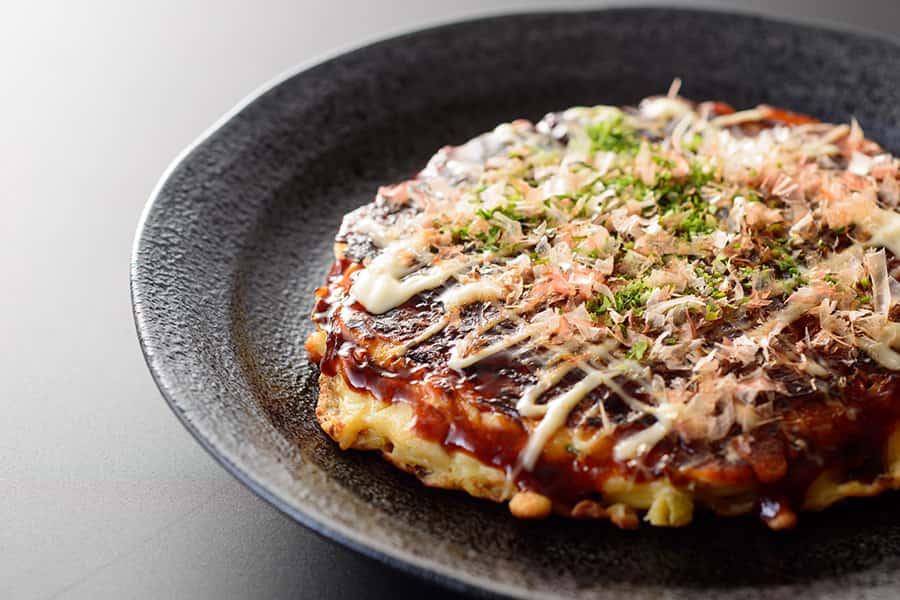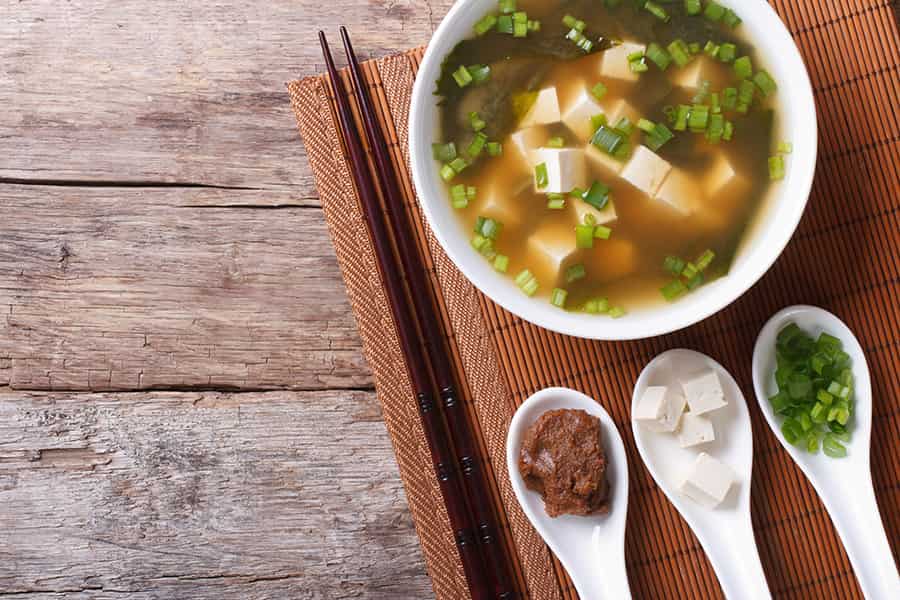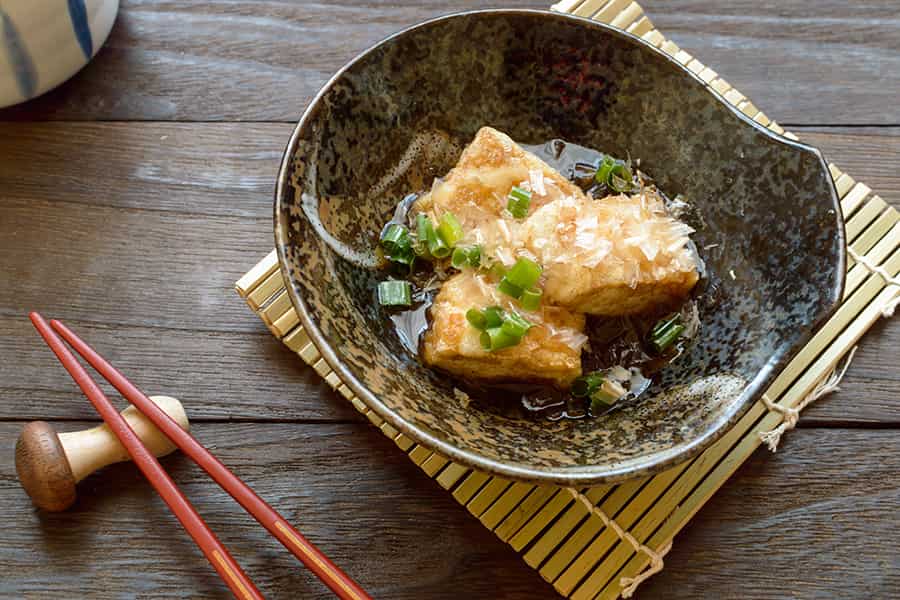- Home
- Leisure & Lifestyle
- Food & Drink
- 9 easy Japanese recipes you can cook at home
Japanese food has a reputation for being healthy, light, and fresh. And, with deliciously deep and complex flavours, it’s also incredibly tasty.
While it might be best known for sushi, Japan’s culinary culture is unusually rich. Not only does Japan have the second most Michelin-starred restaurants in the world, but Japanese cuisine is also known for its profound understanding of umami – that wonderfully satisfying, savoury flavour.
So, if you want to get more familiar with Japanese food, why not try cooking up some delicious dishes? From comforting bowls of miso soup to warming curries and fresh noodle salads, here are nine easy, mouthwatering Japanese recipes you can make at home.
1. Okonomiyaki

Okonomiyaki is a popular Japanese street food from Osaka. It’s a cross between a pancake and an omelette, and because so many types of meat, seafood, and vegetables can be added, it’s a great way to use up any ingredients you have that need eating. The name ‘okonomiyaki’ translates to ‘cooked as you like it’, which should give you an idea of how versatile this dish is!
Other than the batter, the only real ‘essential’ ingredient is shredded cabbage – and, after that, you can add pretty much anything. Most recipes include protein (usually shrimp, beef, pork, seafood, or tofu) and veggies like corn, spring onions, green peas, bean sprouts, and kimchi. Quick and simple to make, okonomiyaki is incredibly satisfying and packed with moreish flavours.
Traditional okonomiyaki uses okonomi sauce, which you can buy from most Asian supermarkets. However, you can easily make your own okonomi sauce by mixing a few condiments you may already have, like Worcestershire sauce and tomato ketchup.
Once your pancake is cooked, cut into quarters, cover with sauce and toppings of your choice, and eat while it’s hot!
For more on making the perfect okonomiyaki, read this article by The Guardian, or have a watch of the video below.
2. Ramen

Ramen is a serious business in the world of food. Arguably the ultimate Japanese comfort food, its popularity has swept across the world. But if you’re a fan of this delicious and nourishing noodle soup (or you’ve never had it), you don’t have to head to a restaurant to enjoy a steaming bowl of it.
The broth is what gives ramen its classic deep, umami flavour, and it’s easily the most important element of the dish. There are all kinds of ramen dishes you can make, but three of the most popular options are miso ramen (which is soybean-based), tonkotsu ramen (which is pork bone-based), and shoyu ramen (which is soy sauce-based).
For the noodles, you can use special ramen noodles, which you can buy dry or fresh in most Japanese and Asian shops, or you can use the thin Chinese-style egg noodles that are available in all supermarkets.
In terms of toppings, pork, tofu, dried nori, and a soft-boiled egg are all popular, and a drizzle of sesame oil finishes things off. Remember that ramen is meant to be slurped, so this is a dish it’s perfectly acceptable to eat noisily!
To find out more about cooking the perfect ramen, have a read of this article by Kitchn. If you’d like to make a rich pork tonkotsu ramen, you could try this recipe from Serious Eats. Or, for a veggie version, their creamy vegan miso ramen should hit the spot.
To see how to make delicious ramen in only 10 minutes, it’s also worth having a watch of the video below.
3. Katsu curry

Katsu curry may be a classic Japanese dish, but its history is a bit more diverse. Curry – as in curry powder – originated in India and was enjoyed by British settlers. It became popular in Japan after British military officers brought curry powder with them when they stayed in Kobe and other cities. So the reason behind katsu curry’s mild taste is because it’s been Anglicised.
Mild it may be, but katsu curry is absolutely delicious. In Japan, if people are making katsu curry at home they’ll usually buy a block of curry roux from the shop rather than making it from scratch. So, if you have an Asian supermarket near you, you might want to see if they sell a Japanese curry roux. If not, however, you can easily make your own from scratch.
Katsu curry is usually served with a pork or chicken cutlet that’s breaded in panko breadcrumbs – although if you’re veggie, you can use sweet potato, aubergine, tofu, or a mock-meat cutlet instead. If you’re a fan of Wagamama’s katsu curry, you might want to try watching this video and making it at home!
Otherwise, why not try making this pork cutlet katsu curry from Bon Appétit? Or keep things plant-based with this aubergine katsu curry from Lazy Cat Kitchen.
To find out more about making katsu curry, check out the video below.
4. Yakisoba

Yakisoba is a popular Japanese noodle dish that’s quick to cook and easily adaptable. And while, in Japan, it’s often cooked on flat-top teppan griddles (like in teppanyaki restaurants), you can easily make it at home. Leftover yakisoba is also especially delicious, so anything you don’t eat can be enjoyed the next day.
Yakisoba noodles are similar to fresh lo mein noodles and are usually bought pre-cooked, – which makes this an easy one-pan recipe! If you can’t find yakisoba noodles, dried soba noodles or egg noodles also work well.
Yakisoba is an interesting dish in terms of origins, as it’s influenced by both Chinese and English cuisine. Yakisoba sauce is based around Worcestershire sauce, but while English-style Worcestershire sauce is thin, strong, and vinegary, the Japanese equivalent is much thicker. You can buy yakisoba sauce from Asian supermarkets or make your own.
Other than the noodles and sauce, you’ll also need to add vegetables and a protein of your choice. Shiitake mushrooms, carrots, cabbage, and bean sprouts work well – while chicken, pork belly, shrimp, and tofu are all popular sources of protein.
To make chicken yakisoba, you could try this recipe from Delish. Or, to make vegan garlic sriracha yakisoba, why not try this recipe from Rabbit & Wolves?
For more guidance on making the perfect yakisoba, you might also like to check out the video below.
5. Miso soup

If you’ve ever eaten in a Japanese restaurant before, chances are you’ve had a bowl of miso soup.
While it’s often served as an appetiser, miso soup is certainly deserving of a place on this list – and its health benefits mean it’s a great dish to add to your diet! And, if you can make a delicious bowl of miso soup from home, all the better.
Miso soup has been an everyday fare in Japan since the Kamakura period (1192-1333), and there’s a reason it’s stuck around so long. Not only is it incredibly good for you, but it’s also one of the easiest and most comforting soups to make – and once you’re able to make tasty miso soup from scratch, you’ll have mastered the backbone of pretty much all great Asian soups: a delicious, umami broth.
Miso soup consists of miso paste (made from fermented soybeans), kombu (dried seaweed), and, often, dried bonito flakes. Then, soft cubes of tofu are added along with sliced spring onions. You can use white miso paste (which is sweeter and lighter), red miso paste (which has been fermented for longer and has deeper, more complex flavours), or yellow miso paste (which falls in between).
To make your own comforting miso soup, why not try this recipe by Kitchn? Or have a watch of the video below.
6. Yakitori chicken

If you’re a fan of barbecued meats, it’s a safe bet to say you’ll probably love yakitori chicken.
In Japan, instead of going to the pub, people like to go to izakayas. The word ‘izakaya’ translates as ‘stay-drink-place’, and it’s a spot where friends get drinks and order delicious small plates. And one of the most popular izakaya dishes is yakitori chicken.
Yakitori literally means ‘grilled chicken’ – but if you’ve ever tried yakitori chicken, you’ll know it’s not any ordinary grilled chicken. Grilled on skewers on charcoal (often along with vegetables like spring onions), what makes yakitori special is the sauce, which is called tare.
Tare is a sweet, sticky glaze that’s usually made from soy sauce, sake, and dark sugar or honey – and when combined with the chicken and hot charcoal, it becomes irresistible.
There are many different types of yakitori, and you can use just about any part of chicken. There’s chicken thigh (momo), breast (muneniku), wings (tebasaki), skin (kawa), liver (kimo), gizzard (sunagimo), hearts (shinzou), and even cartilage (bankotsu). However, chicken thighs and breasts are the fastest and easiest, so you might want to start there.
Why not try this yakitori chicken recipe from RecipeTin Japan? Or, have a watch of the video below to find out more.
7. Agedashi tofu

Aside from yakitori chicken, another dish that’s popular at izakayas – and often enjoyed with sake or Japanese beer – is agedashi tofu.
The first known recipe for agedashi tofu was published in 1782 in a Japanese tofu cookbook called Tofu Hyakuchin (which means ‘one hundred ways with tofu’), and since then it’s been a staple in Japanese cuisine.
If you think you don’t like tofu, this is probably the dish that’ll make you think again! The outside of the tofu is dusted with cornstarch, potato starch, or flour, then lightly fried until crisp, and the inside is so soft it should melt in your mouth. The tofu is served in a warm dashi-based broth that adds a delicious umami flavour, and grated ginger, and sliced spring onion on top add a zingy freshness.
Tofu is an excellent source of protein and is packed with many important nutrients, and while this dish is usually deep-fried, if you’re making it at home it might be easier (and healthier) to shallow fry.
To make your own agedashi tofu, why not try this recipe from Chopstick Chronicles or have a watch of the video below? Serve with sake or Japanese beer for maximum authenticity!
8. Soba noodle salad

If you’re a fan of noodles but are in the mood for a light, refreshing dish, you might enjoy making a soba noodle salad.
Soba noodles are a staple in both Japan and Korea, and these chewy, nutty-tasting buckwheat noodles can be eaten both hot and cold – and because they only take three or four minutes to cook, they’re perfect if you want to knock up a delicious, nutritious, and speedy lunch.
Packed with amino acids and fibre, soba noodles are incredibly versatile. They go well with just about any fresh ingredients you have, from eggs to veg and seafood to tofu. While hot soba soups are popular, a cold soba noodle salad makes a wholesome light-yet-satisfying lunch. Just make sure to watch your noodles as they cook, as they can go from perfect to overcooked in seconds!
Whatever ingredients you decide to use in your soba noodle salad, it’s best to have some seasonal veg, sesame seeds for crunch, and something more filling, like avocado, egg, or another source of protein. Finally, finish off with a flavoursome dressing or dipping sauce.
You might want to try Saveur’s soba noodle salad with miso and grilled prawns – or, alternatively, this vegan soba noodle salad with peanut sauce by From My Bowl.
For more even soba noodle salad inspiration, check out the video below.
Get one month of Rest Less Events for free
Get unlimited access to 80+ online events every month. Discover educational talks and lectures, join beginner friendly fitness classes, discuss your favourite novels at book club, and explore new hobbies with creative workshops!
9. Sushi

And, finally, you can’t have an article on Japanese food and not mention sushi. Perhaps the most iconic Japanese dish, sushi is actually believed to have originated in China between the 5th and 3rd century BC, when fermented rice was used to preserve fish. While it’s widely believed that ‘sushi’ means ‘raw fish’, it refers to vinegared rice served with different accompaniments.
There are many different versions and flavours of sushi, and while some, like California rolls, are modern, Western creations, others have been made and eaten in Japan since the eighth century. Maki is a type of sushi where the ingredients are rolled in nori, a sheet of dried seaweed – and this has been popular since the 1700s, when sheet nori was first invented.
Nigiri is another popular type of sushi. Nigiri sushi features either seafood, vegetables, meat, omelette, or tofu. It was believed to have been created in Tokyo in the 1800s, when an innovative chef wanted to make a quick snack for the workers in the area. But, maki and nigiri are just the tip of the iceberg when it comes to sushi!
Making your own sushi usually requires a bit of practise, as the act of rolling it up can take a while to master – but if you love sushi it’s worth the effort. Being able to make delicious, fresh sushi from scratch won’t only impress your friends, but it’ll also save you money, and, because it’s so versatile, it’s a great way to use up leftover ingredients.
To find out how to make the perfect fish sushi from home, have a read of this sushi guide by Food 52. Or, to browse some of the best veggie sushi recipes, head over to Insanely Good. Alternatively, for something a bit different, why not try our vegan sushi bowl recipe?
To learn more about making sushi, you might also want to watch the video below.
Final thoughts…
Japanese food tends to be seasonal, fresh, and light – but that doesn’t mean it can’t also be indulgent or feel like a treat! More than anything, Japanese food is incredibly versatile, and there’s a delicious dish for every mood and occasion.
If you feel like eating something light and fresh, a cold soba noodle salad or plate of sushi is ideal. If you fancy something comforting, a bowl of warming miso soup or hearty ramen will do the job. And, if you’re in the mood for something that feels like a treat, you can emulate the Japanese and enjoy a plate of agedashi tofu or yakitori chicken, with a cold Japanese beer.
For more culinary inspiration from around the world, why not visit the food and drink section of our website? Here, you’ll find a wide variety of articles including; 8 recipe ideas from around the world and 8 mouth-watering Mexican meals to cook at home.
Are you a fan of Japanese food? Or are you tempted to make any of these recipes? We’d love to hear about your food experiences in the comments below.
Selene Nelson is an author, freelance journalist, and lifestyle writer for Rest Less. After graduating from the University of Sussex with a degree in English Literature, Selene began contributing to many major newspapers and websites, and has written for the BBC, The Sunday Times, The Independent, Town & Country, and HuffPost. Her specialist subjects include food, travel, and health, though she enjoys writing about a wide range of topics (e.g. her two books are about veganism and psychopathy, respectively!). She enjoys cooking (particularly pasta and Asian noodle soups), reading, travelling, hiking, attempting to keep fit, and watching animal videos on YouTube.
* Links with an * by them are affiliate links which help Rest Less stay free to use as they can result in a payment or benefit to us. You can read more on how we make money here.
Quality wines from just £6.25 per bottle
The Wine Society is one of the UK’s leading wine merchants. A one time payment of just £40 gets you lifetime access to The Wine Society, unlocking access to honestly priced, world-beating wines. Plus, free, next day delivery on all orders with £20 off your first order. T&Cs** apply.
**If your order is for a gift, the recipient must be over 18 years. By placing your order, you confirm that the recipient is over 18 years old.
